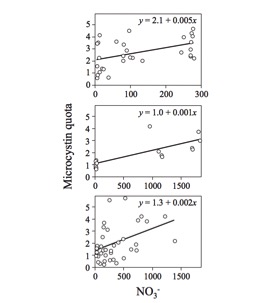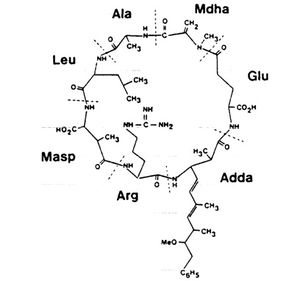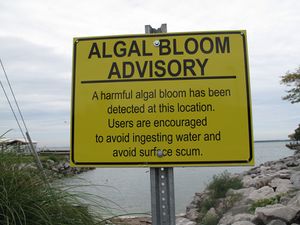Microcystis aeruginosa and the Effects of Microcystin-LR on Ecosystems and Human Health
Introduction

By Lauren Michael
Double brackets: [[
Filename: PHIL_1181_lores.jpg
Thumbnail status: |thumb|
Pixel size: |300px|
Placement on page: |right|
Legend/credit: Electron micrograph of the Ebola Zaire virus. This was the first photo ever taken of the virus, on 10/13/1976. By Dr. F.A. Murphy, now at U.C. Davis, then at the CDC.
Closed double brackets: ]]
Other examples:
Bold
Italic
Subscript: H2O
Superscript: Fe3+
The term “microcystin” refers to a group of liver toxins that are produced by many species of cyanobacteria. The name microcystin comes from the genus Microcystis, one of the most widely known genera that produce this widespread toxin. Microcystis aeruginosa, a photosynthesizing freshwater cyanobacterium, is the most common producer of toxic microcystin, and is often associated with eutrophic fresh water systems, where they form widespread, toxic blooms. Microcystis aeruginosa are Gram-positive cyanobacteria that form colonies ranging from a few individuals to millions of cyanobacteria, and can group together to create blue-green layers of scum on the surface of freshwater systems. This scum blocks light from reaching the bottom of the water column, and can lead to hypoxic zones due to the overconsumption of oxygen during the decomposition of dead cyanobacterial cells.
Microcystin-LR is the most deadly microcystin, and can be dangerous to humans and animals that have long-term contact with it. Microcystin contaminated water poses a major health risk for humans and animals, and has been known to cause mass die offs in contaminated ecosystems, as well as the disruption of major food webs.[1]
Microcystin is a hepatotoxin that most often enters the body through oral ingestion, primarily targeting the liver. In addition, microcystin can promote tumor growth and concentrate in the testes of males. Microcystins are able to bioaccumulate in food webs, causing concentrations to increase at higher trophic levels. Short-term physical contact with Microcystis aeruginosa can result in skin and eye irritations and gastrointestinal disruptions. These symptoms can be heightened in those with hypersensitivity to micocystin toxins. When damaged Microcystis aeruginosa cells lyse, they release microcystins into the water, making it difficult to remove Microcystis from freshwater sources. Microcystins, and in particular, Microcystin-LR, can pose a significant threat to both humans and animals.
Microcystis aeruginosa

Microcystin-LR
Include some current research, with at least one figure showing data.

Dangers to Human Health
Include some current research, with at least one figure showing data.
Dangers to Ecosystems

Conclusion
References
Authored for BIOL 238 Microbiology, taught by Joan Slonczewski, 2016, Kenyon College.
